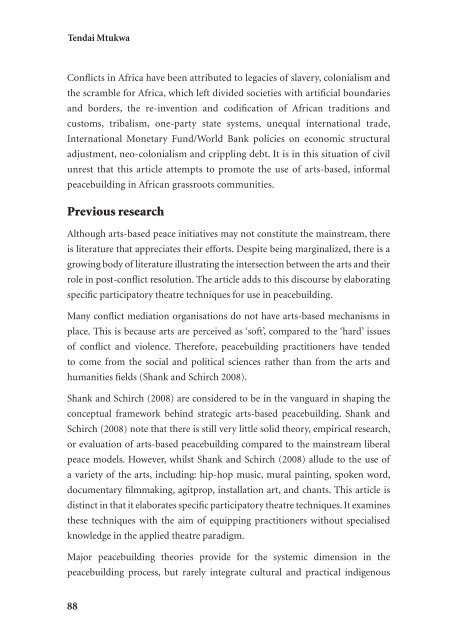ACCORD-ajcr-2015-1
ACCORD-ajcr-2015-1
ACCORD-ajcr-2015-1
- No tags were found...
Create successful ePaper yourself
Turn your PDF publications into a flip-book with our unique Google optimized e-Paper software.
Tendai Mtukwa<br />
Conflicts in Africa have been attributed to legacies of slavery, colonialism and<br />
the scramble for Africa, which left divided societies with artificial boundaries<br />
and borders, the re-invention and codification of African traditions and<br />
customs, tribalism, one-party state systems, unequal international trade,<br />
International Monetary Fund/World Bank policies on economic structural<br />
adjustment, neo-colonialism and crippling debt. It is in this situation of civil<br />
unrest that this article attempts to promote the use of arts-based, informal<br />
peacebuilding in African grassroots communities.<br />
Previous research<br />
Although arts-based peace initiatives may not constitute the mainstream, there<br />
is literature that appreciates their efforts. Despite being marginalized, there is a<br />
growing body of literature illustrating the intersection between the arts and their<br />
role in post-conflict resolution. The article adds to this discourse by elaborating<br />
specific participatory theatre techniques for use in peacebuilding.<br />
Many conflict mediation organisations do not have arts-based mechanisms in<br />
place. This is because arts are perceived as ‘soft’, compared to the ‘hard’ issues<br />
of conflict and violence. Therefore, peacebuilding practitioners have tended<br />
to come from the social and political sciences rather than from the arts and<br />
humanities fields (Shank and Schirch 2008).<br />
Shank and Schirch (2008) are considered to be in the vanguard in shaping the<br />
conceptual framework behind strategic arts-based peacebuilding. Shank and<br />
Schirch (2008) note that there is still very little solid theory, empirical research,<br />
or evaluation of arts-based peacebuilding compared to the mainstream liberal<br />
peace models. However, whilst Shank and Schirch (2008) allude to the use of<br />
a variety of the arts, including: hip-hop music, mural painting, spoken word,<br />
documentary filmmaking, agitprop, installation art, and chants. This article is<br />
distinct in that it elaborates specific participatory theatre techniques. It examines<br />
these techniques with the aim of equipping practitioners without specialised<br />
knowledge in the applied theatre paradigm.<br />
Major peacebuilding theories provide for the systemic dimension in the<br />
peacebuilding process, but rarely integrate cultural and practical indigenous<br />
88


